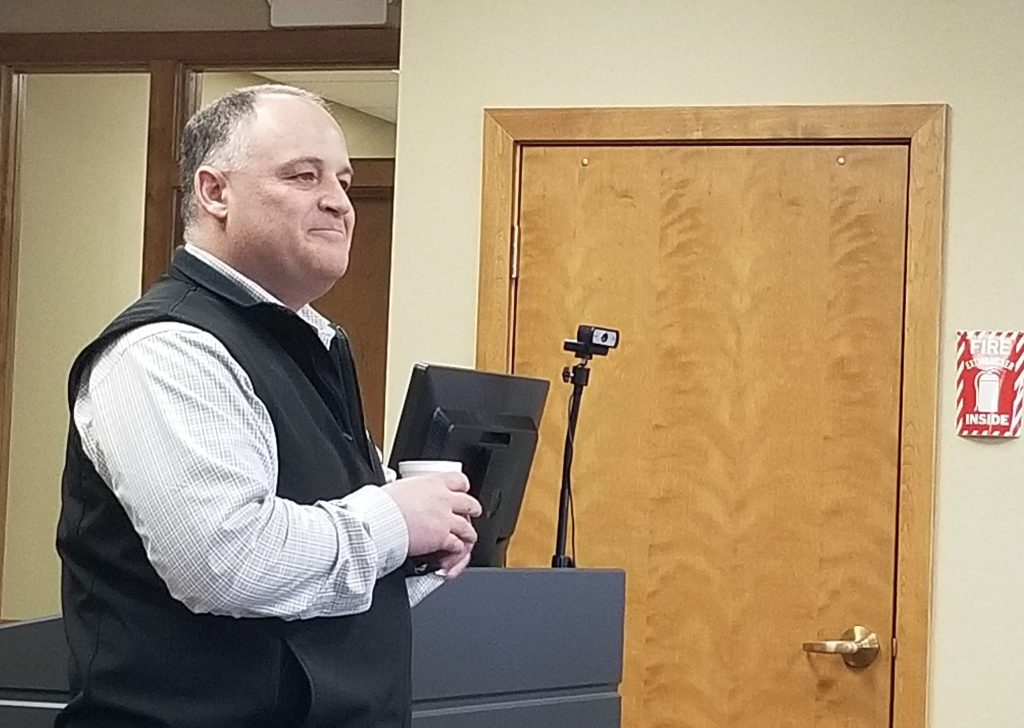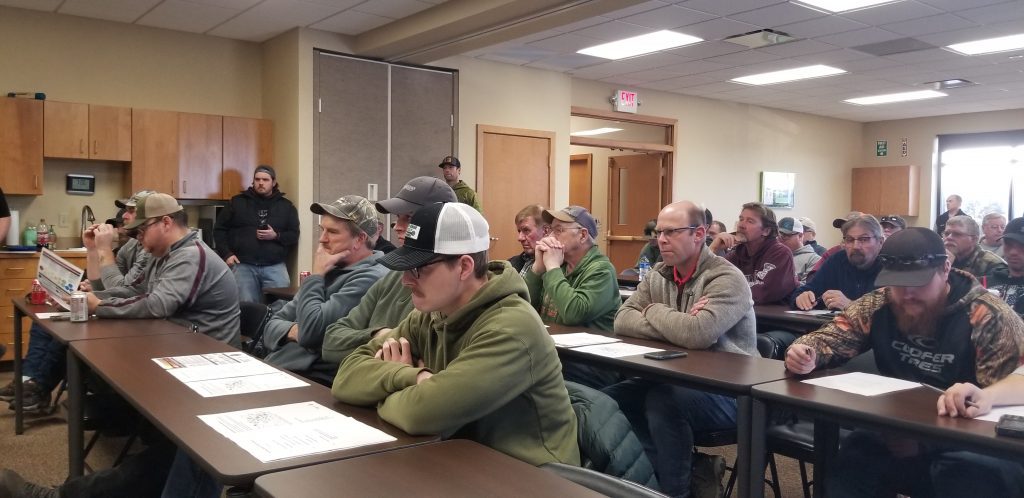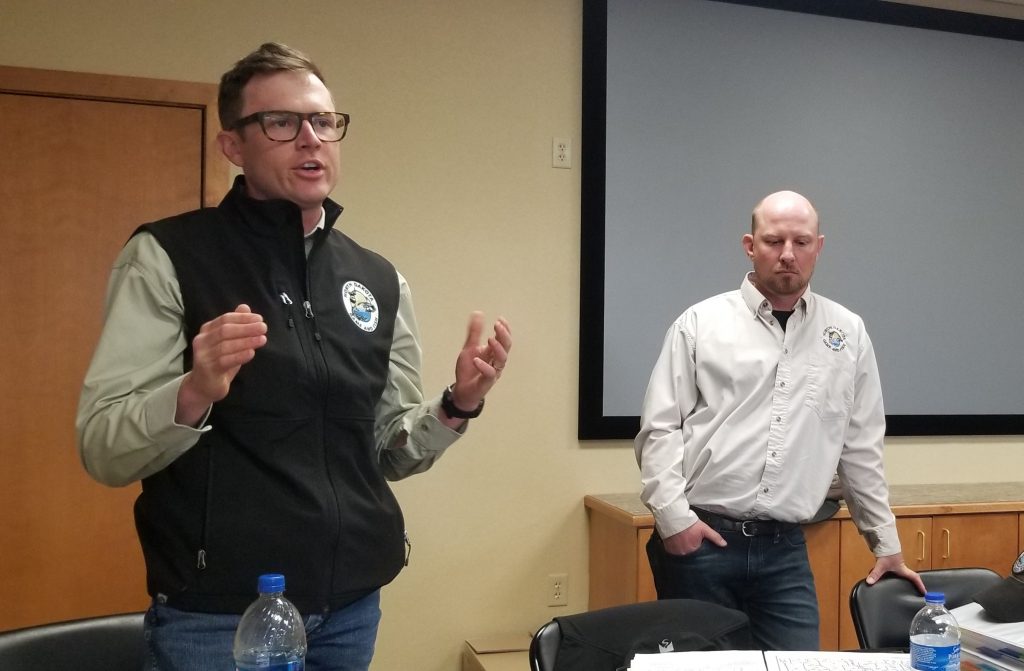

MINOT — The exchange was contentious at times as area sportsmen and landowners expressed their opposition to baiting bans imposed by the North Dakota Game and Fish Department.
The back-and-forth between sportsmen and Game and Fish personnel dominated the District 2 Advisory Board meeting held in Minot, April 25. Game and Fish holds Advisory Board meetings twice a year in each of eight districts in the state, spring and fall. District 2 includes the counties of Ward, Bottineau, Burke, McHenry, Mountrail, Pierce, and Renville.
The hot topic of the evening was the Game and Fish response to the confirmed presence of chronic wasting disease, or CWD, in deer in a growing number of deer hunting units in the state. CWD is a fatal disease, spread primarily through contact from one deer to another. Game and Fish has banned baiting for deer in hunting units where CWD has been identified through laboratory testing.
The back-and-forth between sportsmen and Game and Fish personnel dominated the District 2 Advisory Board meeting held in Minot April 25. Game and Fish holds Advisory Board meetings twice a year in each of eight districts in the state, spring and fall. District 2 includes the counties of Ward, Bottineau, Burke, McHenry, Mountrail, Pierce, and Renville.The hot topic of the evening was the Game and Fish response to the confirmed presence of chronic wasting disease, or CWD, in deer in a growing number of deer hunting units in the state. CWD is a fatal disease, spread primarily through contact from one deer to another. Game and Fish has banned baiting for deer in hunting units where CWD has been identified through laboratory testing.
“We’re doing what we can to reduce that risk, to try and slow down that spread of CWD,” said Jeb Williams, NDGF director, in addressing the gathering. “We’re concerned about deer hunting 30 to 50 years from now.”

A member of the audience countered that, “I had 400 deer in my hay yard and you have a ban on a bucket of corn. That's worthless in stopping CWD. Baiting in my unit has been banned for 12 years. The CWD rate hasn’t changed for 12 years.”
Another commented that, “Baiting takes away from archery hunters getting into the sport.”
The remark was met with considerable applause.
Charlie Bahnson, NDGF veterinarian, responded, “We’re simply doing our best to slow down how fast this disease moves through the population, knowing we have an obligation to do so, for hunters now and through the coming generations. We use the best available information to make the best decisions. It’s that simple.”

Aaron Esquibel, Minot, had a very different reason for voicing opposition to deer baiting bans. Esquibel is a leader with Prairie Grit Adoptive Sports, an organization that takes disabled youth hunting.
“Last year it was a significant blow when Unit 3A4 got the bait ban,” said Esquibel. “The deer have to come to us. This ban had unintended consequences. A bait ban in 3A4 when there was just one positive CWD test miles and miles away from us? You are taking away an opportunity. I’m trying to figure out why.”
Bill Hass, assistant Wildlife Division chief, explained, “We control what we can control. We don’t want deer to congregate year-round. That location is often a bait pile. Eventually, unless something miraculous happens, CWD is going to cover the entire state. CWD builds every year. We do what we can to limit the risk out there.”
Boat Ramps, Fishing
The availability of ramps, necessary to allow access to the water for boaters and fishermen, was very much on the mind of sportsmen. Greg Power, NDGF Fisheries Division chief, shared some good news with the group regarding Lake Sakakawea which is several feet lower than it has been for several years.
“By Memorial Day, hopefully, 32 of 35 sites on Lake Sakakawea will be operational,” said Power. “An extra couple of feet of water in the lake would make it better, but it’s not as dire as it could have been.”
Low water in Lake Sakakawea has made some ramps unusable with others considered marginal. In addition, low water ramps that were installed several years ago when Lake Sakakawea was much lower than it is today, have emerged from beneath the dropping water. Some of those ramps will likely see service again this year.
“Typically, problems are really minor, like the cleaning up of ramps,” said Power. “In some cases we’ll need to build a road to low water boat ramps. Some are useable, some are not. With the latest snow and rain, maybe we’ll have a little bit of a rise in water levels.”
A yearly concern for fisheries biologists, and anglers, is whether or not smelt will experience a successful spawning season. Smelt are a primary forage fish in Lake Sakakawea. It is expected they will begin spawning in the next few days.
“It’s good news and bad news,” said Power. “The lake is quite low for smelt. We made it through the last couple of years but the bad news is, the smelt are getting top heavy. A lot of them are three to four years old (maximum life span), so we badly need a new year class and low water is not good stuff for smelt spawning.”
Smelt spawn over gravel cobble in six inches of water, or less. Much of their spawning area along the shores of Lake Sakakawea is already exposed due to low water, generally leaving only mud or silt covered habitat. In addition, if Lake Sakakawea’s decline continues, any smelt that do spawn will have their eggs exposed to the elements.
“It’s important for what happens a couple of years from now,” explained Power, recalling the years when Lake Sakakawea experienced poor smelt spawns and skinny game fish.
Game and Fish wraps up their spring Advisory Board circuit with meetings in Jamestown, May 2, and Hettinger, May 3.